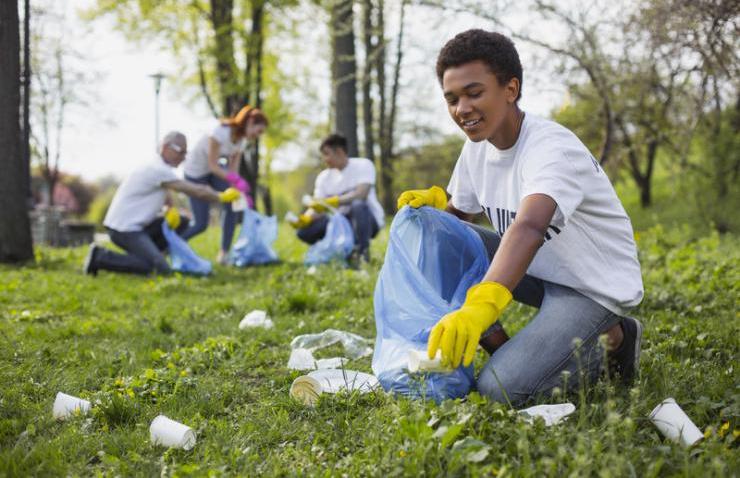Living without destructive plastic.

Plastic was and is a magical invention. It is a material based on oil and has thousands of excellent and life-saving uses. In the medical world, in construction, in tool-making, manufacturing of phones and other gadgets, cars, household items, furniture and almost everything you see has plastic in it.
Our modern world depends on plastic to sustain its present lifestyle. But that lifestyle built on the plastic revolution has its dangerous dark side. Everything we humans use and discard can have dire consequences for the planet. Garbage is everywhere and it is damaging our health. Plastic pollution is destroying many creatures and poisoning our air and rivers and oceans and people don’t seem to care.
It is dangerous to health because it is a destructive chemical-based pollutant and it is the one-time use of disposable plastic stuff that is so dangerous and damaging to our lives, our health, our environment. The fish we eat have plastic in them because the vast oceans are filling up with discarded plastic. If you Google ‘Plastic Pollution in Manila’ you will get a sight that will make you cry or angry. You will see photos of the esteros, canals, rivers and Manila Bay choked with millions of discarded plastic bottles, cups, straws, bags, nets and wrappings. Eventually some drifts into the far ocean.
These single-use plastic items make up 40 percent of all annual plastic production worldwide. They are with us forever, you might say, and will not disintegrate for about 400 years. The millions of tons of floating plastic will eventually join the great Pacific garbage patch that covers a surface area that is 1.6 million square kilometres. That is three times the size of France. It is swirling in ocean currents between California and Hawaii and elsewhere. There are many other lesser known floating garbage islands where our discarded single-use plastics end up.
The ocean currents sweep up the floating plastic in gyre regions as they are called. An estimated 297 million tons of plastic is out there on the ocean currents distributed as follows: in the North Pacific (36 percent), Indian Ocean (22 percent), North Atlantic (21 percent), South Pacific (8 percent) and the South Atlantic (4.5 percent). The Mediterranean Sea has 8.5 percent. We humans sure dirty
our own planet.
What is most dangerous to all living creatures in the short and long term is the damage to our health from micro-plastics. The plastic bottles, cups, straws and bags eventually breakdown into tiny micro-plastic particles and even Nano-plastics.
A massive eight million tonnes every year float into the oceans and tons of plastic dust are blown into the atmosphere from the tons of plastic in open pit garbage dumps. We breathe the dust into our lungs. It may be necessary to always wear a mask.
The micro-plastics get into everything- our throats, lungs and stomachs- and they harm wildlife, too. Fish are found dead their stomachs filled with plastic bags. Tests have shown micro plastics are in many caught fish on our dinner tables. I have gone vegetarian.
Birds are dying by the thousands from eating plastic items. Penguins, albatrosses and many sea gulls have died as a result of eating floating or submerged plastics. Thousands of dolphins, sharks, whales and turtles are caught in the drifting discarded plastic fishing nets of the commercial fishing industry.
What incredible damage we are doing to wild nature, ourselves and our children by such irresponsible I-don’t-care behaviour.
Discarded one-use plastic is a culture of death and destruction. Researchers have found items from almost every continent floating in the garbage patch and cast up on remote Pacific islands. They have been found in the deepest part of the ocean to the highest point on earth, Mount Everest, no less. Europe and the United States have their garbage and plastic disposable and recycling challenges yet Asia is the source of most of the plastic garbage.
The plastic garbage monster is coming not only from the Pasig in Manila where most of it stays in coastal waters but mostly it is coming down the five major Chinese rivers and also from the Nile in Egypt, the Ganges in India, the Indus in Pakistan, the Niger in Africa and the Mekong River that passes through Laos, Thailand and Cambodia.
There is one way to solve this: a worldwide ban on single use plastics like plastic bags, cups, bottles, drinking straws stir-sticks, cutlery and food containers. There are laws in place in some countries banning plastic bags. In the Subic Bay Freeport Zone, plastic bags are banned in stores and super markets. More restrictions are coming in the US and the EU but not soon enough. The Philippines needs such laws to save our beautiful islands and rivers and beaches. Burying the garbage in the sand is not the answer.
Beach and environmental clean ups are good and we see youth cleaning up other people’s dirty environmental mess that is destroying the ecology. Speeches are important but action is more effective.
It will be so much better to prevent the plastic pollution by passing and implementing laws to get all stores, supermarkets, and food establishments to use only recyclable bio-gradable packaging
and wrapping.
Each of us can do our part. We can always have your own reusable water bottle, demand restaurants give a glass, ceramic or paper cup and paper straw and refuse to order if they use plastic. Look for bio-degradable materials. We can bring a shopping bag to the supermarket and never use plastic that is not biodegradable. At home or in the office, we separate all discarded materials and make a weekly trip to the recycling bins. If we all did these things, it would make a big difference. Let’s make a start. But we have to persuade government to act and pass stricter laws to end the plastic pollution in the Philippines and elsewhere.
Fr Shay Cullen (Manila, Philippine)
Photo: © Can Stock Photo / Zinkevych



